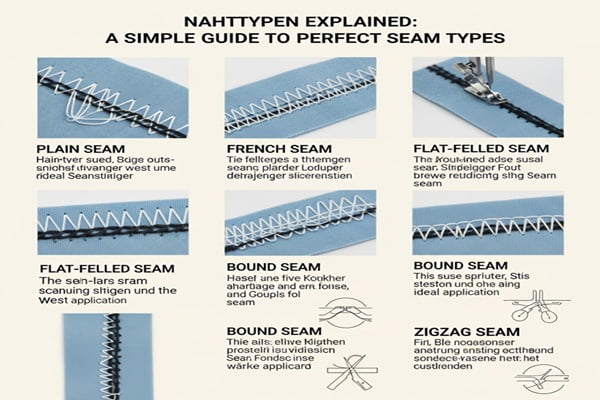
If you’ve ever wondered why some clothes feel more comfortable, last longer, or simply fit better—the secret often lies in something most people overlook: the seam. Yes, those tiny stitches holding everything together can make or break a garment.
In the world of sewing and textiles, these seams are known as Nahttypen (a German word meaning “seam types”). Whether you’re a seasoned tailor, a DIY crafter, or just curious about how your jeans or shirts are stitched, understanding nahttypen can completely change how you approach sewing projects.
Let’s explore the fascinating world of seams—where art meets engineering—and learn how to pick the perfect one for your next creation.
What Are Nahttypen and Why Do They Matter?
Simply put, a seam joins two or more pieces of fabric together using stitching. But seams do so much more than just connect fabric—they shape how your garment looks, moves, and lasts.
Think about it:
-
A strong seam keeps your jeans from tearing.
-
A smooth seam makes formal wear look elegant.
-
A stretchy seam lets your workout clothes move with you.
Every stitch affects a garment’s durability, flexibility, and comfort. That’s why choosing the right nahttypen isn’t just about aesthetics—it’s about functionality.
The international textile standard ISO 4916:1991 actually classifies seams into eight main categories, including:
-
Superimposed seams
-
Lapped seams
-
Bound seams
-
Flat seams
-
Decorative stitching
-
Edge finishes
-
Attachments
-
Single-ply constructions
Each serves a unique purpose depending on fabric type, tension, and design needs.
1. Plain Seam – The Classic Workhorse
The plain seam is the most common and straightforward of all seam types. You simply place two pieces of fabric right sides together and stitch along the seam line.
It’s perfect for everyday garments and beginner projects—but it’s important to finish the raw edges (with pinking shears, zigzag stitch, or an overlocker) to prevent fraying.
Best for: Cotton shirts, dresses, pillowcases, and other basic sewing projects.
Pro tip: Press your seams flat before stitching for a cleaner look.
2. French Seam – Elegance on the Inside
If you want your sewing to look as neat on the inside as it does on the outside, go with the French seam.
This seam hides raw edges inside a folded enclosure, creating a clean and professional finish—ideal for delicate fabrics like chiffon or silk where every detail shows.
How it’s done:
-
Sew wrong sides together with a narrow seam.
-
Trim the edge slightly.
-
Flip fabric right sides together and sew again, enclosing the first seam.
Best for: Lightweight, sheer, or luxury fabrics.
Why it’s special: It looks refined, feels smooth, and prevents fraying—no serger required!
3. Flat-Felled Seam – Built to Last
Ever looked closely at your jeans and noticed double rows of stitches? That’s a flat-felled seam—the powerhouse of durability.
This method folds one seam allowance over the other, enclosing raw edges and sewing them flat. The result? A strong, professional-looking finish that can withstand serious wear and tear.
Best for: Jeans, workwear, uniforms, and outdoor gear.
Bonus: It’s reversible—both sides look tidy, which is great for unlined garments.
4. Overlocked Seam – Fast and Flexible
If you’re after speed and stretch, the overlocked seam is your go-to. It’s made using a serger (overlock machine), which trims, sews, and seals edges in one go.
This is the seam that gives modern clothing that stretchy, polished look. It’s especially popular in athletic wear, T-shirts, and knit garments.
Best for: Jersey, spandex, and knit fabrics.
Pro tip: Use four-thread overlocking for extra durability.
5. Bound Seam – Strength Meets Style
The bound seam is both practical and decorative. Instead of leaving edges exposed, you cover them with bias tape—a strip of fabric cut on the bias for flexibility.
Not only does this stop fraying, but it also adds a pop of color or contrast to your garment’s interior. It’s often used in unlined jackets or handmade bags.
Best for: Unlined garments, bags, and curved edges.
Creative tip: Try contrasting bias tape for a fun, designer touch.
6. Zigzag Seam – The Handy Quick Fix
No fancy machine? No problem! The zigzag seam is your best friend for finishing raw edges using a regular sewing machine.
Just set your machine to a medium-width zigzag stitch and sew along the edge—it keeps fabric from fraying and works surprisingly well on light to medium-weight materials.
Best for: DIY projects, home décor, or fabrics that fray minimally.
Why it works: Simple, versatile, and beginner-friendly.
How to Choose the Right Seam Type
Choosing the right nahttypen is like picking the perfect recipe—it depends on your ingredients (fabric), your purpose (garment type), and your tools (equipment).
Here’s a quick guide to make the choice easier:
1. Match the Seam to the Fabric
-
Lightweight fabrics (chiffon, silk): Use French seams.
-
Heavy fabrics (denim, canvas): Go for flat-felled seams.
-
Stretch fabrics (knit, spandex): Overlocked seams are ideal.
-
Medium-weight cotton or linen: Plain seams work just fine.
2. Think About the Garment’s Purpose
-
High-stress areas (shoulders, waistlines, inseams): need durable seams like flat-felled or reinforced stitching.
-
Decorative edges: Bound or topstitched seams can enhance visual appeal.
3. Consider the Look and Feel
-
Formal clothing: Choose clean, invisible finishes like French seams.
-
Casual wear: Visible stitching adds charm and structure.
-
Reversible garments: Use fully enclosed seams for a professional look inside and out.
4. Test Before You Stitch
Always try a sample seam on scrap fabric before starting your main project. This helps you:
-
Check how the seam behaves on curves or edges.
-
See if the thickness affects drape or comfort.
-
Confirm the overall look before committing.
5. Keep Practicality in Mind
If you’re sewing for business or bulk production, balance quality with efficiency. Some seams take more time and skill—so factor that into your workflow.
Also Read : Taco Bell Secret Menu 2024: 16 Delicious Hacks You Have to Try!
Why Seam Choice Matters So Much
Seams are the unsung heroes of the sewing world. The right seam not only keeps your clothes together but also defines how they perform, feel, and last.
Here’s why your seam choice can make or break a project:
-
It determines durability – strong seams prevent splitting.
-
It affects comfort – smooth seams reduce chafing.
-
It influences appearance – neat seams make clothes look professional.
-
It boosts functionality – stretch or water-resistant seams enhance performance wear.
Choosing wisely ensures your creations don’t just look good but also stand the test of time.
Conclusion: Stitching It All Together
Mastering nahttypen isn’t just for professionals—it’s for anyone who wants to make their sewing projects more durable, comfortable, and beautiful. From the simplicity of a plain seam to the precision of a French seam, each stitch tells a story of craftsmanship and care.
Before starting your next project, remember:
-
Match your seam to your fabric and purpose.
-
Test first, then sew with confidence.
-
A well-chosen seam elevates your work from “homemade” to “handcrafted.”
Seam techniques will continue to evolve with new fabrics and technologies, but their importance remains timeless. With a little practice and curiosity, you can turn any piece of fabric into something that’s built to last—and looks amazing too.
FAQs About Nahttypen
Q1. What are the most common seam types?
Plain seams, French seams, flat-felled seams, overlocked seams, and bound seams are the most widely used. Each offers a unique balance of strength and style.
Q2. How do I choose the right seam for my project?
Base your decision on fabric weight, garment purpose, and the tools you have. Lightweight fabrics prefer French seams, while heavy-duty materials need flat-felled construction.
Q3. Which seam is best for high-stress areas?
Flat-felled seams are ideal—they’re extra strong and reinforced, perfect for jeans and workwear.
Q4. Are there seams that balance comfort and looks?
Yes! French seams give a smooth, elegant finish that’s as comfortable as it is beautiful.
Q5. Why does seam choice matter in sewing?
Because it affects everything: the fit, durability, and longevity of your garment. A good seam ensures your creation stays strong, stylish, and wearable for years.


